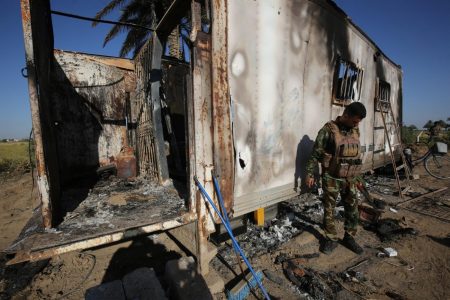
Islamic State’s ‘Battle of Ramadan’ rocks Iraq and spreading fears of resurgence
In the very early hours of Saturday morning, six youths busily prepared a pre-dawn meal before the long hours of Ramadan fasting began.
Relaxed, they drifted away from their observation point in Mukeshefah, a town on the Tigris River’s west bank some 40km south of Tikrit, and indulged in endless tales as they cooked in a caravan.
At no point did the paramilitary fighters notice the eyes that were watching them.
Moments later, masked by the total darkness that the rural farm area was submerged in, a group of Islamic State (IS) militants doused the caravan with gasoline and then sprayed it with bullets. By the time reinforcements arrived, the six charred bodies were all that remained of the young men.
The attackers, who investigations found were fully aware of the number of forces present, their arms and their daily habits, were not satisfied with killing the six youths.
Instead, they planted an explosive device on the road leading to the caravan, detonating it as soon as a support force arrived, killing another three and wounding four, security sources told Middle East Eye.
How many militants staged the attack and how they got to the youths’ position is unclear, though Iraqi intelligence is sure they fled to the Tigris and disappeared into the night by boat.
Hours later, at 9pm, another group of IS militants attacked a police station in the village of Zaghaniya, in northeast Diyala, killing four police and wounding a further 10, security sources said.
As in the earlier attack, an ambush had been laid, and reinforcements came under fire as soon as they arrived, with gunfire wounding three policemen and destroying two of their vehicles.
Well-planned, slickly executed and ruthless, the two assaults have raised the possibility that, two years after its territorial defeat, the Islamic State group is capable of replicating the fearsome operations that once left Iraq reeling.
A senior military officer, speaking on condition of anonymity, sought to play down these fears: “The two operations were not high profile and did not mean that IS has regained its ability to carry out major operations.”
The assaults, he insisted, instead reflect the “scale of neglect and relaxation” of the forces stationed at the two sites.
“The same mistake always recurs. Calm breeds relaxation, speed creates confusion and the two lead to disaster,” he said.
Still, fears have been stoked that an IS resurgence in Iraq’s Sunni heartland could begin to emerge.
Suicide operations and attacks targeting Iraqi forces and civilians have decreased significantly since December 2017, when the Iraqi government announced IS’ defeat and the liberation of all areas the militant group had captured in the country’s north and west.
Since then, IS has lost the ability to carry out major attacks and its militants have gone underground, operating as sleeper cells that are activated whenever the opportunity arises.
That activity has sharply risen alongside the start of the holy month of Ramadan, with a total of four attacks across different governorates.
The Mukeshefah and Zaghaniya attacks were not the first, but they were the deadliest.
IS began what it has called the “Battle of Ramadan” with a suicide attack carried out by a militant wearing an explosive belt, which he detonated at the entrance of the Directorate of Intelligence and Counter-Terrorism in Kirkuk on 28 April, wounding two, security sources told MEE.
That was followed by a series of attacks concentrated in the triangle that extends between the governorates of Diyala, Kirkuk and Salah al-Din, known as the Hamrin Basin, targeting army and police patrols or the positions manned by the Popular Mobilisation (Hashd al-Shaabi) paramilitary forces.
The Basin is bordered by the Hamrin Mountains, which extend from the northeast of Diyala governorate to the northwest of the Tigris, and pass through areas north of Salah al-Din and southern Kirkuk.
Source: Middle East Eye





